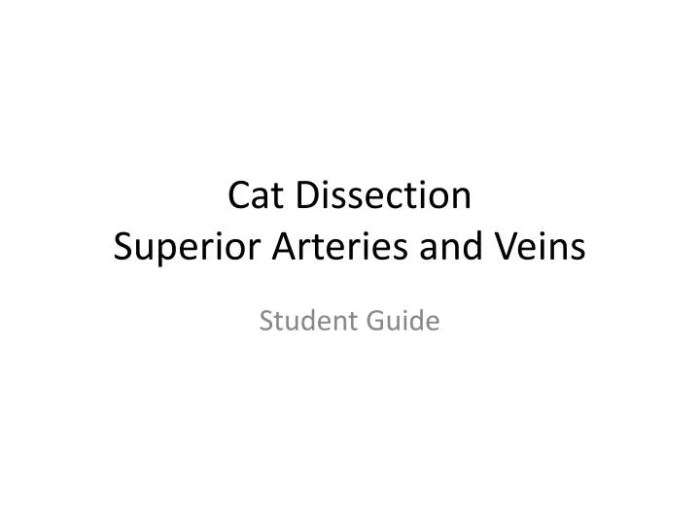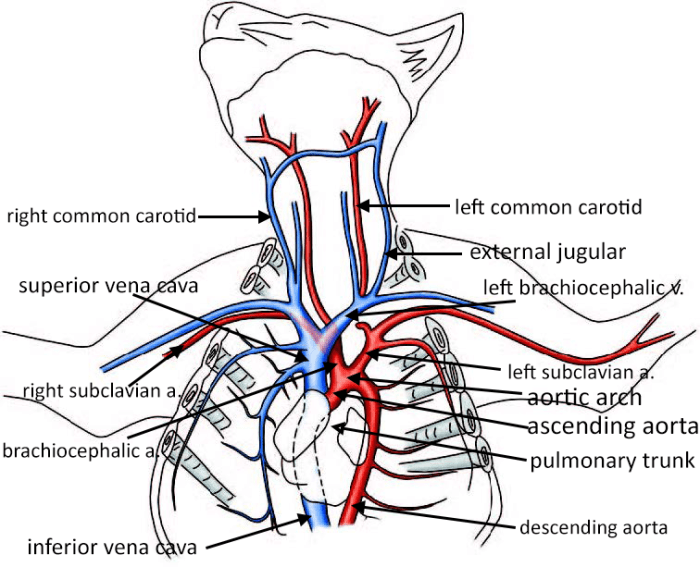Delving into the intricate network of cat dissection veins and arteries unveils a fascinating chapter in feline anatomy, providing invaluable insights into the circulatory system of these captivating creatures.
Our exploration begins with an examination of the arterial supply to the cat’s head, neck, thoracic limbs, and abdominal and pelvic regions, meticulously detailing the intricate pathways that deliver oxygenated blood throughout the body.
Arterial Supply to the Cat
The arterial supply to the cat is derived from the aorta, which originates from the left ventricle of the heart. The aorta ascends through the thoracic cavity and arches over the heart to enter the abdomen. Along its course, it gives off several branches that supply the head, neck, thoracic limbs, abdominal and pelvic regions.
Arterial Supply to the Cat’s Head and Neck
The arterial supply to the cat’s head and neck is provided by the carotid arteries. The common carotid artery arises from the aortic arch and divides into the external and internal carotid arteries. The external carotid artery supplies the structures of the face, while the internal carotid artery supplies the brain.
Arterial Supply to the Cat’s Thoracic Limbs
The arterial supply to the cat’s thoracic limbs is provided by the subclavian arteries. The subclavian arteries arise from the aortic arch and pass through the thoracic cavity to enter the axilla. In the axilla, they divide into the axillary artery and the brachial artery.
The axillary artery supplies the muscles of the shoulder, while the brachial artery supplies the muscles of the forearm and paw.
Arterial Supply to the Cat’s Abdominal and Pelvic Regions
The arterial supply to the cat’s abdominal and pelvic regions is provided by the abdominal aorta. The abdominal aorta descends through the abdominal cavity and gives off several branches that supply the digestive system, kidneys, and reproductive organs. The pelvic arteries arise from the abdominal aorta and supply the pelvic limbs and reproductive organs.
Venous Drainage of the Cat: Cat Dissection Veins And Arteries

The venous drainage of the cat is accomplished by a system of veins that return blood to the heart. The veins are divided into two systems: the systemic veins and the pulmonary veins. The systemic veins collect blood from the body and return it to the right atrium of the heart.
The pulmonary veins collect blood from the lungs and return it to the left atrium of the heart.
Venous Drainage of the Cat’s Head and Neck
The venous drainage of the cat’s head and neck is accomplished by the jugular veins. The jugular veins are located on either side of the neck and collect blood from the head and neck. The jugular veins join together to form the brachiocephalic vein, which then enters the right atrium of the heart.
Venous Drainage of the Cat’s Thoracic Limbs
The venous drainage of the cat’s thoracic limbs is accomplished by the brachial veins. The brachial veins are located on either side of the forearm and collect blood from the muscles of the forearm and paw. The brachial veins join together to form the axillary vein, which then enters the brachiocephalic vein.
Venous Drainage of the Cat’s Abdominal and Pelvic Regions
The venous drainage of the cat’s abdominal and pelvic regions is accomplished by the abdominal veins. The abdominal veins collect blood from the digestive system, kidneys, and reproductive organs. The abdominal veins join together to form the caudal vena cava, which then enters the right atrium of the heart.
Comparative Anatomy of Cat Arteries and Veins
The arterial and venous systems of cats are similar to those of other mammals. However, there are some unique features of the cat’s circulatory system. For example, the cat’s heart is relatively small and located more centrally in the thoracic cavity than in other mammals.
Additionally, the cat’s aorta is relatively short and gives off several branches that are not present in other mammals.
Arterial Systems of Cats and Other Mammals
- The arterial systems of cats and other mammals are similar in that they both consist of a heart, arteries, and capillaries.
- However, there are some differences in the branching patterns of the arteries in cats and other mammals.
Venous Drainage in Cats and Other Mammals
- The venous drainage in cats and other mammals is similar in that they both consist of veins, capillaries, and a heart.
- However, there are some differences in the branching patterns of the veins in cats and other mammals.
Unique Features of the Cat’s Circulatory System
- The cat’s heart is relatively small and located more centrally in the thoracic cavity than in other mammals.
- The cat’s aorta is relatively short and gives off several branches that are not present in other mammals.
Clinical Significance of Cat Arteries and Veins

Understanding the arterial supply and venous drainage of the cat is important for several reasons. First, it allows veterinarians to diagnose and treat diseases of the circulatory system. For example, a veterinarian may need to know the location of the arteries and veins in order to perform a blood transfusion or to administer medication.
Importance of Understanding the Arterial Supply to the Cat, Cat dissection veins and arteries
- The arterial supply to the cat is important for several reasons.
- First, it allows veterinarians to diagnose and treat diseases of the circulatory system.
- Second, it allows veterinarians to perform surgical procedures on the cat.
Importance of Comprehending the Venous Drainage of the Cat
- The venous drainage of the cat is important for several reasons.
- First, it allows veterinarians to diagnose and treat diseases of the circulatory system.
- Second, it allows veterinarians to perform surgical procedures on the cat.
Examples of How Knowledge of the Cat’s Circulatory System Can Aid in Veterinary Medicine
- Knowledge of the cat’s circulatory system can aid in veterinary medicine in several ways.
- First, it allows veterinarians to diagnose and treat diseases of the circulatory system.
- Second, it allows veterinarians to perform surgical procedures on the cat.
General Inquiries
What are the unique features of the cat’s circulatory system?
Cats possess a highly efficient circulatory system characterized by a relatively large heart and a complex network of arteries and veins, ensuring optimal blood flow to all parts of the body.
How does knowledge of the cat’s circulatory system aid in veterinary medicine?
Understanding the cat’s circulatory system is crucial for diagnosing and treating various cardiovascular conditions, guiding surgical procedures, and administering medications effectively.